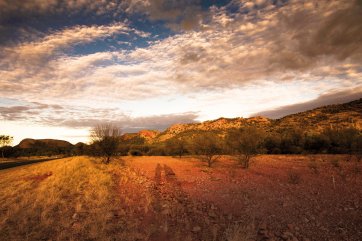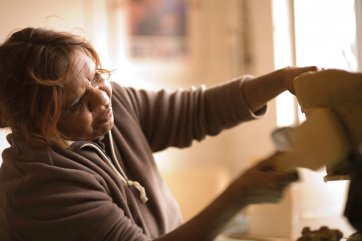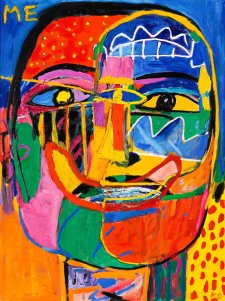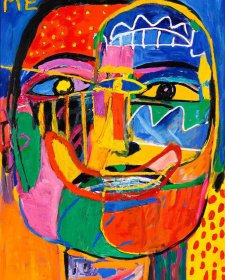Group portraits are not unusual but it is fair to say that amongst all the school class photographs, images of military troops and sports teams, group portraits that are truly outstanding are rare.
One thinks of Rembrandt’s Night watch 1642, Las Meninas 1656 by Diego Velázquez or Francisco de Goya’s Charles IV and his royal family of 1801. Even the languorous set of female movie queens by Annie Leibovitz in the exhibition Vanity Fair Portraits: Photographs 1913–2008 might be included in this pantheon of greats, but the fact remains that this is a difficult and unusual format for portraits. All the more reason to celebrate the National Portrait Gallery’s first commissioned group portrait. Not only is it a successful and beautiful work, it is also unusual in that it is actually a group self portrait.
The new commission is a portrait of the Hermannsburg Potters by themselves. Characteristically, it is a terra cotta vessel, underglazed and decorated by the senior artists of the Aranda community, Clara Ngala Inkamala, Rahel Kngwarria Ungwanaka, Dawn Ngala Wheeler, Irene Mbitjana Entata, Virginia Mbitjana Rontji, Rona Panangka Rubuntja, Hayley Coulthard, Lindy Panangka Ronji and Anita Mbitjana Ratara. Hermannsburg is a former Lutheran mission located 130 kilometres west of Alice Springs in the Northern Territory.
It is home to a remarkable group of Indigenous women who have created a distinctive style of terra cotta vessels decorated with small figures of animals, birds and plants as well as painted scenes and motifs from the local region. The pottery was established in 1990 when Aboriginal Pastor Ungwanaka, recalling the sale of clay figures to visitors in the 1950s, encouraged the local people to revisit their interest in modelling with a view to creating a viable industry. The pottery thrived, becoming a source of revenue for the community and an important form of traditional and modern expression for the local people. Since then, Hermannsburg pots have made their way into national and international collections.
Each of the artists has a individual style and approach but they were encouraged to work together to create a pot that was also a self portrait. Steve Anderson the arts advisor at Hermannsburg says that ‘the pot depicts each artist’s particular iconographic reference to the local flora and fauna from their country and surrounding homelands. This work signifies the group working together toward a unified outcome’. Their practice, the making of clay pots, is pictured on the cap of the vessel in a model by Irene Entata of three women working together on a single giant pot. The potters themselves are pictured on the sides of the pot, but not in the manner of conventional portraiture. Each of the artists is represented by their totem. Clara Ngala Inkamala, for example, is represented with an emu and chicks, and Rahel Kngwarria Ungwanaka is associated with the owl. This substitution or connection between and individual and an entity or familiar is not uncommon in Indigenous art – Ginger Riley Munduwalawala is particularly known for his paintings that include Ngak Ngak the sea eagle which watches over Riley’s country in Western Australia as a totemic self portrait.
Dawn Wheeler presents a lively kookaburra on branch, complete with flashes of blue on its wings, Virgina Rontji has painted two magpies alert and looking in opposite directions, while Lindy Rontji paints two desert lizards banded pink and brown as if decorated for a corroboree. Anita Ratara paints a young mother with two toddlers who sit on the ground waiting for her to pluck bush tucker from a berry laden shrub. Irene Entata depicts the Lutheran mission that is at the center of Hermannsburg and in the forecourt, paints the artist selling work to a tourist while an interested woman and child look on.
The series of portraits are separate but cooperatively placed in a belt around the belly of the vessel. Behind the major subjects are groups of smaller animals and behind them are the orange creases of the Macdonald Ranges. The arrangement of bigger entities around the protruding girth enhances the sense of perspective as the scale diminishes into the mountainous backdrop painted on the receding neck of the pot. The Hermannsburg Potters have produced both an unusual self portrait and a magnificent gallery of work by highly respected women artists.


















